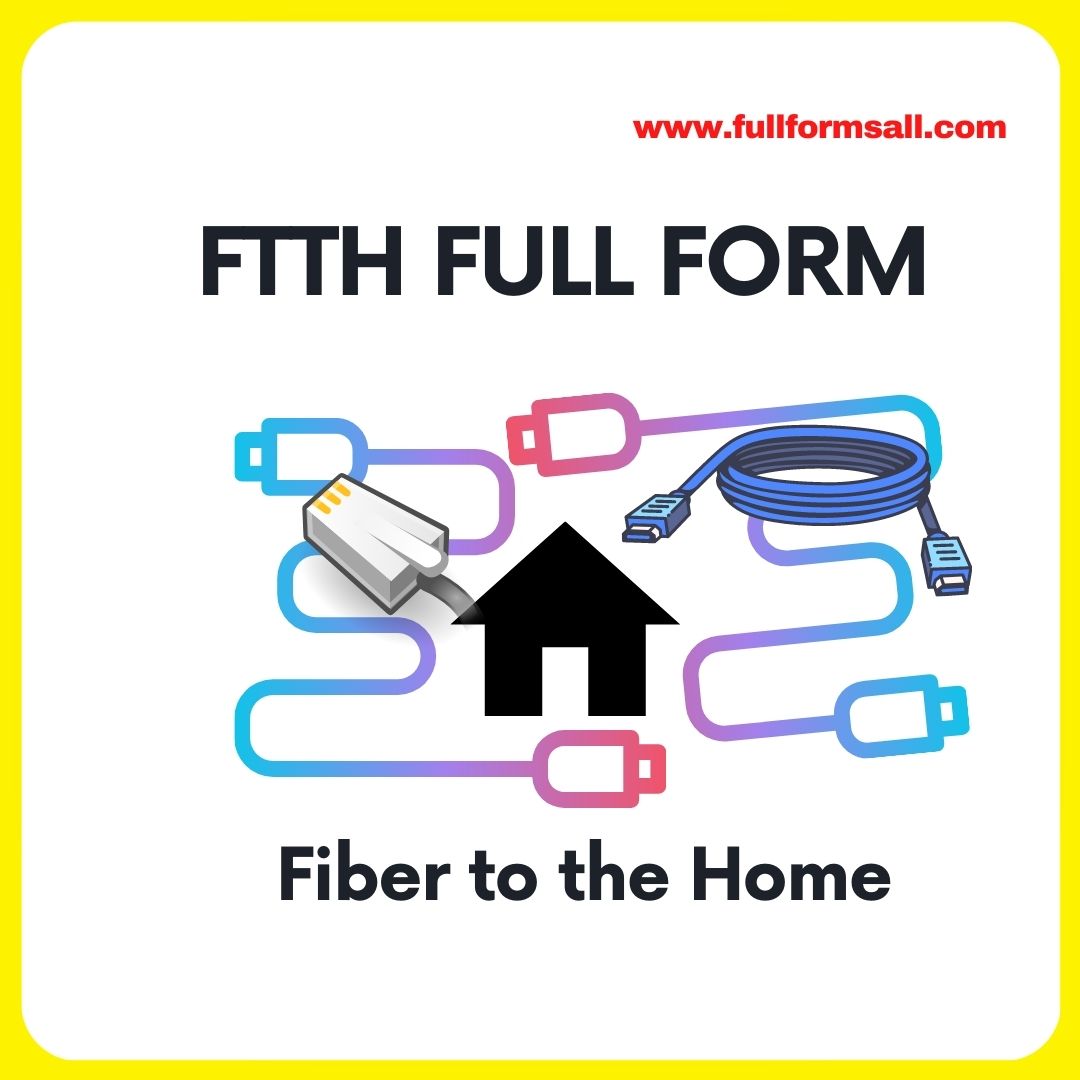In this article you get to know about FTTH full from and other different abbreviations of FTTH in various fields. FTTH full form refers to Fiber to the Home.
Fiber to the Home is a type of broadband internet connection that uses fiber optic cables to deliver high-speed internet access directly to individual homes or buildings. This technology is also known as Fiber to the Premises. Traditional internet connections rely on copper cables, which transmit data through electrical signals. In contrast, fiber-optic cables transmit data through pulses of light, allowing for much faster and more reliable internet speeds.
FTTH involves running fiber-optic cables from a service provider’s network directly to a customer’s home or building. The cables are then connected to an ONT or modem, which converts the optical signals into electrical signals that can be used by devices such as computers, phones, and smart TVs.
One of the key advantages of FTTH is its ability to deliver extremely fast internet speeds. With FTTH, users can enjoy download and upload speeds that are several times faster than traditional cable or DSL connections. This is especially beneficial for bandwidth-intensive activities such as streaming high-definition video, online gaming, and video conferencing.
FTTH also offers other benefits such as greater reliability, lower latency which is the time it takes for data to travel between a device and the internet, and increased security. Since fiber-optic cables are made of glass or plastic, they are less susceptible to interference from electromagnetic radiation, weather conditions, and other factors that can affect copper cables. FTTH can be more expensive to install than other types of internet connections, since it requires laying new fiber-optic cables. It may also be less widely available in certain areas, since the infrastructure required to support it is not yet as widely deployed as traditional copper-based internet connections.
Advantage of FTTH is its ability to support multiple users and devices simultaneously without experiencing a significant decrease in speed. This is because fiber-optic cables have a much higher bandwidth capacity than copper cables, which allows for greater data transfer rates and more simultaneous connections. Furthermore, FTTH can also support advanced internet services such as video-on-demand, cloud computing, and virtual reality applications. These services require a high-speed, low-latency connection, which FTTH can provide.
FTTH also has environmental benefits since fiber-optic cables are more energy-efficient than traditional copper cables. Fiber-optic cables require less energy to transmit data over long distances, which reduces the carbon footprint associated with internet usage. FTTH offers future-proofing capabilities, meaning that it can support emerging technologies and higher internet speeds as they become available. This eliminates the need for costly upgrades or installations in the future.
FTTH is its potential to improve healthcare, education, and other public services. With high-speed internet connectivity, remote health monitoring, telemedicine, and virtual consultations become possible, improving access to healthcare for individuals living in remote or underserved areas.
In the education sector, FTTH can provide students with access to online learning resources, virtual classrooms, and video conferencing with teachers and peers, regardless of their geographical location. This can help bridge the digital divide and improve access to education for students in rural or low-income areas.FTTH can also benefit businesses by improving their productivity, efficiency, and competitiveness. With faster internet speeds, businesses can quickly transfer large files, access cloud-based applications, and collaborate with remote teams in real-time. This can lead to faster decision-making, better customer service, and reduced operational costs. FTTH can enhance the overall quality of life for individuals and communities by enabling access to a wide range of entertainment and leisure activities such as video streaming, gaming, and social media. It also facilitates online shopping, banking, and other e-commerce activities.
FTTH can increase property values and attract new businesses and residents to areas that offer this advanced internet connectivity. This can have a positive impact on local economies, creating jobs, and boosting growth and development.
One of the challenges of FTTH deployment is the cost of infrastructure investment, which can be significant. However, there are several funding models that can help to finance these projects, such as public-private partnerships, government subsidies, and community-based initiatives.
Community-based initiatives, in particular, have emerged as a popular way to fund FTTH deployment in areas where traditional providers have not yet invested. These initiatives involve communities coming together to invest in their own fiber-optic networks, either through crowd-funding campaigns or by forming cooperative organizations. Another challenge of FTTH deployment is the need for careful planning and design to ensure that the network is optimized for the needs of the community it serves. This includes factors such as the number of users, the type of services they require, and the distance between users and the central network. The installation and maintenance of FTTH networks require specialized skills and expertise, which may not be readily available in all areas. As a result, there is a need for training programs to develop a skilled workforce capable of designing, building, and maintaining these networks.
FTTH is a high-performance, reliable, and future-proof internet connectivity solution that offers a wide range of benefits to users. While it may be more expensive to install, its superior performance and scalability make it a worthwhile investment for both individuals and businesses. FTTH is a transformative technology that offers numerous benefits to individuals, businesses, and communities. With its superior performance, scalability, and future-proofing capabilities, it has the potential to revolutionize the way we live, work, and interact with the world around us.
Different abbreviations of FTTH in various fields are as follows
| Term | Abbreviation | Category |
| FTTH | Fibre To The Home | Computing |
| FTTH | Fiberoptic To The Home | Computing |
| FTTH | Fiber to the House | Computing |
CONCLUSION:
Dear reader in this article you get to know about FTTH full from and FTTH term used in various other fields, If you have any query regarding this article kindly comment below.

